Tired of buying a new pair of socks only to have them almost immediately become threadbare? Check out these durable sock brands that are built to last.
Did you know there are about 2,000 steps in every mile? Now think about how it feels when every one of those steps quickly builds to worn-out socks and blisters. Ouch. Save yourself some pain and cash by investing in the best quality organic socks that last forever (well, almost forever. I mean, you and I won’t be around to check).
Here are our Leaf Score picks for the best durable, hardwearing organic socks around, plus a few extras made with recycled and eco-friendly materials to further extend your socks’ lives.
There’s also a quick guide below to figure out the best socks for your needs.
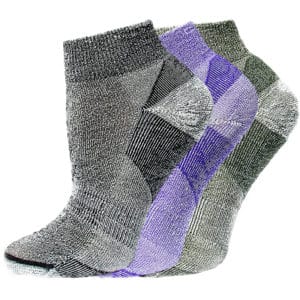
Maggie’s Organics
Highlights: Maggie’s Organics are the bees knees when it comes to organic socks. All of their socks are made with certified organic fibers and comply with the Global Organic Fiber Standard (GOTS). They use USDA certified organic wool from sheep on small family farms in Argentina and spin the yarn and make the socks in North America.
Maggie’s Organics knit their designs with great care at family-owned-and-operated knitting mills in North Carolina and Alabama. Because these mills (which have been spinning and knitting yarn for over 300 years!) use slower, older-style machines, this puts less stress on the natural fibers, meaning your socks last longer!
The yarn is treated with a GOTS certified chlorine-free anti-felt treatment, which means they’re machine washable. Most of their socks are made with around 70% organic merino wool, plus 1% Spandex, and 29% nylon or polyester to enhance durability, fit, and comfort. They’ve been in the business since 1992 and clearly know what they’re doing.
Maggie’s Organics is a member of the Fair Trade Federation, Domestic Fair Trade Association, Free2Work, and Green America. They ship their socks in biodegradable packaging, with recyclable boxes. And all their products are latex and rubber free, free from petroleum solvents, and are colored with GOTS certified low impact dyes free from heavy metals and formaldehyde. They only use hydrogen peroxide as a natural whitener, never bleach. You can see the whole sock-making journey here.
Some of our favorites from Maggie’s Organics include:
Organic Wool Mountain Hiker Socks – made for the winter, this heavy-duty, moisture-wicking sock is perfect for hiking, camping, and just generally staying cozy, warm, and dry. Super soft and comfortable, with thick cushioning throughout, these socks are made with 72% organic merino wool, 27.5% nylon, and 0.5% Spandex, and they’re machine washable! Available in solid colors and mixed.
Organic Wool Killington Hiking Sock – available in Black and size 10-13, these machine washable socks are a great mid-calf choice for icy cold weather. Made with 66% organic merino wool, 32% nylon, and 2% Spandex for an ultra comfortable fit that springs back into shape after washing.
Cotton and Wool Sweater Socks – knit with a cute sweater design, these socks are made from 52.4% organic merino wool, 27.2% organic cotton, 19.3% nylon, and 1.1% Spandex, making them a little lighter and thinner (and lower cost!) than Maggie’s Organics woolier socks.
Maggie’s Organics Organic Cotton Athletic Crew Socks – made with 75.4% Organic Cotton, 13.72% Repreve Recycled Polyester, 9.68% Nylon, and 1.2% Spandex, these are a great workout sock! The recycled polyester helps to wick away moisture, the webbed cotton top reduces friction, and the Spandex helps these mid-calf beauties stay in place no matter how hard you push yourself.
Etsy has a few fantastic options for high quality organic socks that last forever. Beware, though, as not all listings (in fact, very few!) that use the word organic actually back up that claim with any certifications. Check for USDA and/or GOTS and ask to see labels before paying more for greenwashed items.
Two of our top finds for organic socks on Etsy are:
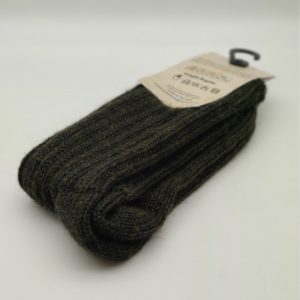
Etsy: Irish thick organic wool socks
Highlights: Handmade in Ireland using 100% organic wool from Irish sheep.
These snug hiking socks are handmade in Ireland using 100% organic wool from Irish sheep. The yarn is dyed using a process that complies with OEKO-Tex standards and the socks are available in two sizes in a gorgeous dark green and a heather gray.
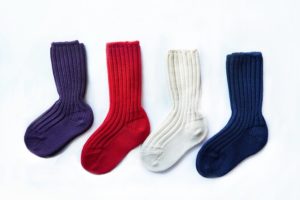
Etsy: 100% ORGANIC WOOL Kid’s Socks
Highlights: Made from GOTS certified organic wool, and colored with non-toxic dyes.
Suitable for babies aged 9 months through to kids 6 years old, these cozy and soft socks are handmade in Germany using 100% organic wool with GOTS certification. The yarn is colored with non-toxic dyes and is not treated with bleach, formaldehyde or other toxic chemicals. Socks ship for free in the US from Cypress, Texas, in just 1-2 business days and start at less than twenty bucks!
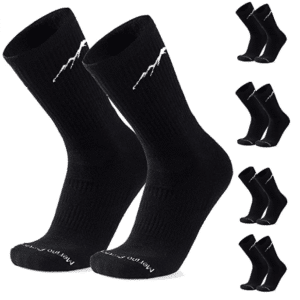
Merino Protect Organic Merino Wool Socks – 4-pack
Highlights: Formulated with 53% Organic Merino Wool sourced from organically farmed sheep in Australia and New Zealand.
Available in Black and Men’s sizes 6-12 and 12-16, these quality hiking socks are made using 53% Organic Merino Wool, 25% Nylon, 17% Polyester, and 5% Spandex, offering durability and a little stretch. The merino wool is sourced from organically farmed sheep in Australia and New Zealand, and the socks are machine washable in cold water (line dry only!).
These Arch Compression Crew Socks offer greater stability and extra comfort thanks to the full cushion foot and clever design.
Finally, these socks are not made with entirely organic materials but are much more eco-friendly than regular socks. Made with recycled polyester and nylon, these hardwearing socks help to keep plastics out of landfill and out of the oceans and waterways. And they’ll keep your feet nice and toasty and blister-free too!
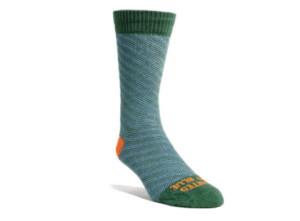
United By Blue SoftHemp Socks
Highlights: Naturally antibacterial thanks to its composition that includes organic cotton and hemp.
Available at REI, the United by Blue SoftHemp Socks are made using 35% organic cotton, 33% nylon, and 31% hemp, plus 1% Spandex making them hardwearing, naturally antibacterial, and super comfortable. They get softer with every wash, sit at the lower calf (crew height), and for every pair of socks sold, United by Blue removes a pound of trash from the ocean or waterways.
These socks don’t offer much in the way of cushioning, however, so don’t rely on them as hiking socks. Consider them, instead, a ‘brunch sock’, for casual strolling around the city or lounging at home.
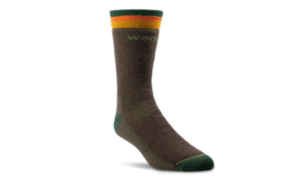
Woolrich Midweight Top Stripes Socks
Highlights: Created from excess yarns that may have otherwise been wasted in a variety of colors and designs.
Super soft and thick, these hiking socks are the result of an innovative partnership between REI Woolrich. Together, they use excess yarns that may have otherwise been wasted to make gorgeous socks in a variety of fun colors and designs. The exact colors will vary, but the materials include 73% merino wool, 25% nylon, and 2% Lycra spandex.
These are great socks for thermoregulation, natural odor resistance, and are super durable, quick drying, and moisture-wicking. The socks feature seamless toe closures to minimize rubbing and are made in the US.
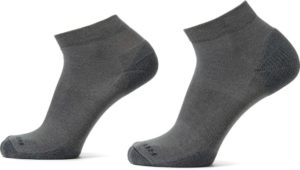
REI Co-op COOLMAX EcoMade Everyday Quarter Socks – 2 Pairs
Highlights: These socks feature COOLMAX EcoMade polyester that’s made in part from recycled water bottles.
Available in grey and white, with reinforced toes and heels, these durable, cushioned ankle socks make daily strolls much more comfortable. Featuring 53% COOLMAX EcoMade polyester – made from recycled water bottles – blended with 38% stretch nylon, 8% new polyester, and 2% Spandex, these socks fit great, wick away moisture, dry fast, and can be machine washed and tumble dried on low. They’re made in the US too!
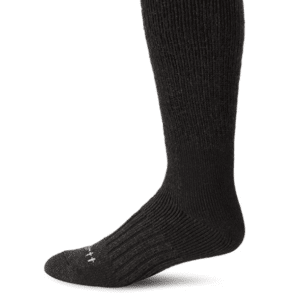
Carhartt Men’s Full Cushion Recycled Wool Crew Socks
Highlights: A popular choice for workers on their feet all day. Well-cushioned, and odor resistant.
Made from 38% Polyester, 30% Recycled Wool, 30% Acrylic, and 2% Spandex, these super-popular socks from Carhartt keep your feet warm and cozy and offer a lot of lovely cushioning. Great work socks to wear in hard boots, they resist odor and stay warm and dry all day.
How to choose the best socks for your needs
Few things are as pleasurable as finding the perfect pair of socks. And few things are worse than ill-fitting socks that rub and wear and make your feet sweaty, smelly, and generally unhappy. So, how do you choose the best socks for your needs? Here are a few things to consider:
- Sock height: Bushwhacking through dense brush or scaling mountains in bulky mountaineering boots? You’re going to need some tall socks that help protect your legs. Conversely, if you’re looking for socks that stay hidden, you’ll want a much shorter, ankle sock. For the in-betweens, crew socks are just the ticket.
- Fabric: More on this below, but the main thing is to consider the climate where you are and how waterproof your shoes. Some fibers wick moisture really well and others can end up a sweaty, soggy, trench-foot-inducing mess in no time at all. In general, you’ll want to choose organic merino wool socks with a dash of recycled polyester or nylon to extend durability, enhance fit, and improve drying time, comfort, and warmth. Or, for summertime forays, go for organic cotton or hemp blended with recycled synthetic fibers.
- Design and cushioning: Good quality organic socks that last forever are usually made with extra cushioning in areas where your feet face the most pressure. This helps reduce overall bulk and the risk of rubbing while protecting your feet when pounding the pavement or hitting the trails. Watch out too for seamless toes or hidden seams to enhance comfort, and extra cushioning to keep toes cozy and warm.
- Fit: Slouchy socks are great for lounging around at home, but if you’re out and about you want your socks to fit nice and snug. This helps to keep blisters at bay by preventing loose material moving around and rubbing your skin over and over.
Common fibers used for making socks include wool, cotton, polyester, nylon, and Spandex. The latter is usually added as a tiny percentage of the overall make-up of the sock and helps the socks retain their shape, stay up, and minimize bunching.
Polyester is another common sock fiber and is well regarded for insulating, drying quickly, and wicking away moisture. This synthetic fiber is obviously not an eco-friendly choice, but some sock makers are beginning to cotton onto using recycled polyester in socks, which we love! This can help remove plastic waste from oceans and keep it out of landfills.
Nylon is similar to polyester in that it can help improve durability and speed up drying. Important things to consider if you’re on a multiday hike and don’t want to pack new socks every day. Nylon is often blended with wool or cotton to make for a softer, more comfortable fit.
Wool is, by far, the most popular fiber for durable hiking socks and any socks meant to last forever. This natural material helps your feet regulate temperature, meaning they stay warm and cozy in colder weather and nice and cool in warmer weather. Wool has some natural waterproofing and dirt-proofing qualities, is antimicrobial and is less likely to hold onto smells. This means you can usually wear wool socks for a good few days before they need a rinse. As a bonus, wool is naturally flame resistant, so you’re less likely to get some nasty burns if you stick your feet to close to a camp fire at night.
Merino wool is best for socks as it is far less itchy than old-school rag wool socks. Merino wool is also popular for socks because it has high loft, meaning it traps heat efficiently, offering a lot of warmth relative to its weight.
As for cotton, this lightweight fiber is a good choice for thin, casual socks on temperate days. On cold days, cotton won’t keep you warm. It’s also terrible when it gets wet, so don’t go hiking in non-waterproof boots with cotton socks.
Looking for more sustainable items to fill your eco-friendly closet with? We’ve got you covered with the following posts: